
Bacterial soft rots leaf spots blights wilts
Xanthomonas spp.
What are Bacterial soft rots (Erwinia, Pseudomonas, and Xanthomonas spp.)?
Bacterial soft rots, leaf spots, blights, and wilts caused by Erwinia, Pseudomonas, and Xanthomonas spp. are plant diseases that affect a wide range of plants worldwide. These diseases can infect various plants including chrysanthemum, geranium, begonia, poinsettia, carnation, and delphinium. Symptoms include water-soaked lesions, yellowing, browning, and black spots on leaves, stems, and blossoms. Soft, watery decay, cankers, and wilting may also occur. The diseases thrive in conditions with high humidity, warm temperatures, and prolonged leaf wetness.
How do Bacterial soft rots (Erwinia, Pseudomonas, and Xanthomonas spp.) occur?
Erwinia, Pseudomonas, and Xanthomonas spp. reproduce and spread through various means. They can enter plants through wounds, natural openings like stomata, or contaminated propagative materials. Splashing water, rain, wind, and contaminated tools aid in their dissemination. The bacteria multiply within the plant tissues, leading to the development of symptoms. They can also be transmitted through infected plant material, irrigation water, or soil.
Symptoms
1 - Effects on Plants
Bacterial soft rots cause decay, weakening plants, hindering growth, and potentially leading to plant death. These diseases result in crop and plant loss, negatively impacting agricultural productivity and biodiversity.
2 - Effects on Soil
• Bacterial diseases can impact soil health and microbial communities. Bacteria released from infected plants can disrupt the soil's microbial balance and nutrient cycling processes, potentially leading to soil degradation and nutrient imbalances.
Solutions
1 - Prevention
• Use certified disease-free seeds, cuttings, transplants, or other propagative materials from reputable sources. • Clean and sanitize tools, containers, and other equipment to minimize the spread of bacteria. • Use drip irrigation or other methods that keep foliage dry. • Remove and destroy infected plant material promptly to prevent the bacteria from spreading to healthy plants. • Maintain balanced nutrient levels to promote plant health and strengthen their resistance to diseases. • Avoid repeatedly planting susceptible species or related plants in the same area.
2 - Treatment
• Consider using beneficial bacteria or biological control agents that can suppress or outcompete pathogenic bacteria. • In some cases, copper-based fungicides can be used to help control bacterial diseases. Follow the instructions on the product label and apply them as recommended. • In severe cases, antibiotics may be used under the guidance of professionals to control specific bacterial diseases. • This should be done according to local regulations and with consideration for potential resistance development.
